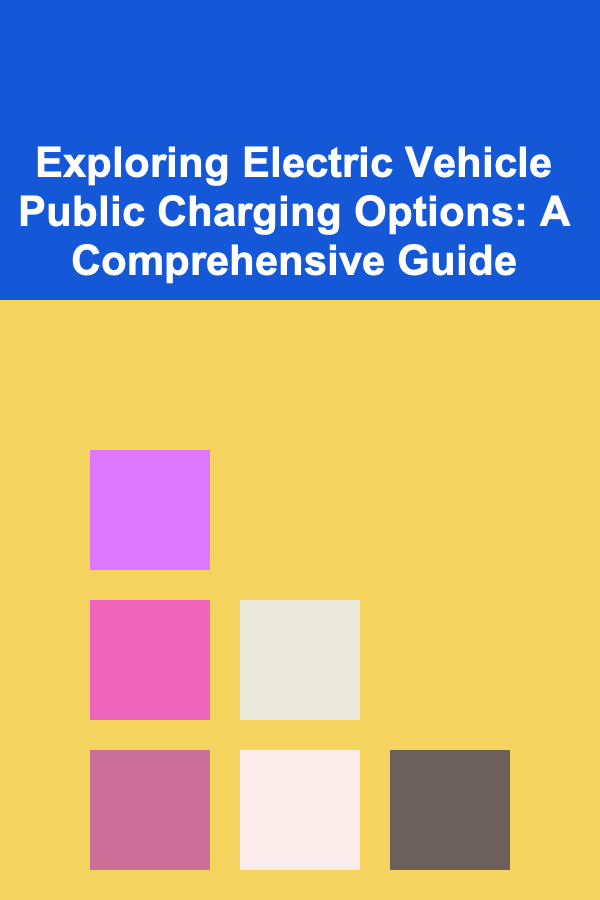
Exploring Electric Vehicle Public Charging Options: A Comprehensive Guide
ebook include PDF & Audio bundle (Micro Guide)
$12.99$7.99
Limited Time Offer! Order within the next:

The adoption of electric vehicles (EVs) is rapidly increasing as concerns about environmental sustainability and the desire for reduced running costs gain prominence. However, a critical aspect of EV ownership is access to charging infrastructure, particularly public charging options. This guide provides a comprehensive exploration of the landscape of public EV charging, covering everything from understanding different charging levels and networks to navigating pricing models and planning your charging strategy.
Understanding EV Charging Levels
The first step in navigating the public charging ecosystem is understanding the different levels of charging available. These levels dictate the speed at which your EV battery can be replenished and are crucial for planning your charging stops effectively.
Level 1 Charging: The Slowest Option
Level 1 charging utilizes a standard 120V AC household outlet. This is the slowest charging method, typically adding only 3-5 miles of range per hour. It's generally suitable for overnight charging at home but is rarely found at public charging stations. While extremely convenient because it requires no special equipment beyond the charging cable that comes with most EVs, its slow speed makes it impractical for public charging scenarios.
Level 2 Charging: The Most Common Public Option
Level 2 charging employs a 240V AC outlet, similar to those used for large appliances like dryers or ovens. This level significantly increases charging speed, adding 12-80 miles of range per hour, depending on the vehicle's onboard charger and the amperage of the charging station. Level 2 chargers are the most prevalent type found at public charging stations, workplaces, and homes. They utilize a J1772 connector, which is the standard for most non-Tesla EVs in North America. Charging times can vary significantly, from a few hours for a partial charge to overnight for a full charge. Consider the charging station's amperage rating and your vehicle's maximum charging rate to estimate charging time accurately.
DC Fast Charging (DCFC): The Fastest Charging Available
DC Fast Charging (also known as Level 3 charging) delivers direct current (DC) electricity directly to the EV battery, bypassing the vehicle's onboard charger. This allows for significantly faster charging speeds, adding 50-350+ miles of range per hour, depending on the charger's power output and the vehicle's charging capabilities. DCFC stations are typically located along major highways and in urban areas to facilitate long-distance travel. They use different connector types, with CCS (Combined Charging System) being the most common for non-Tesla EVs in North America, and CHAdeMO used by some older EVs. Tesla uses its proprietary connector (NACS) but increasingly offers CCS adapters or dual charging cables. DCFC is ideal for quick top-ups during road trips or when you need a fast charge to continue your journey. Note that frequent DCFC usage can potentially degrade battery health over the long term, so it's generally recommended to use it sparingly and rely on Level 2 charging whenever possible.
Exploring Public Charging Networks
A variety of public charging networks operate across different regions, each with its own coverage, pricing models, and features. Understanding these networks is essential for planning your charging strategy and choosing the most suitable options for your needs.
Major Charging Networks in North America
- Tesla Supercharger Network: Tesla's proprietary charging network is renowned for its reliability and extensive coverage, primarily catering to Tesla vehicles. While initially exclusive to Tesla owners, Tesla has begun to open up some Supercharger locations to non-Tesla EVs, offering a wider availability of fast charging options. Tesla uses its own connector (NACS), but adaptors are available for CCS vehicles.
- Electrify America: Electrify America is one of the largest open DC fast charging networks in North America. It offers high-powered charging stations at various locations, including highway rest stops and retail centers. Electrify America supports both CCS and CHAdeMO connectors, accommodating a wide range of EVs. They have a tiered pricing structure based on charging speed and energy consumption.
- ChargePoint: ChargePoint operates a vast network of Level 2 and DC fast charging stations, primarily focused on workplaces, parking garages, and retail locations. ChargePoint uses a variety of pricing models, set by the individual station owners, so prices can vary significantly. You typically need a ChargePoint account and app to initiate charging.
- EVgo: EVgo focuses primarily on DC fast charging and offers a subscription-based membership program. They provide charging solutions for various EV models and often partner with automakers to provide discounted charging rates. EVgo stations predominantly use CCS and CHAdeMO connectors.
- Blink Charging: Blink Charging operates a network of Level 2 and DC fast charging stations, often found at hotels, shopping centers, and parking facilities. Blink offers both pay-as-you-go and membership options. Their coverage varies by region.
Regional and Smaller Charging Networks
In addition to the major networks, numerous regional and smaller charging networks exist, often serving specific geographic areas or catering to niche markets. These networks can provide valuable charging options in areas where larger networks may have limited coverage. Examples include:
- Greenlots (now part of Shell Recharge): While previously independent, Greenlots was acquired by Shell and integrated into the Shell Recharge network. It offered a mix of Level 2 and DC fast charging stations.
- FLO: A prominent network in Canada and parts of the US, FLO offers both public and private charging solutions.
- Many utility companies also operate small networks of charging stations within their service areas.
Finding Charging Stations: Apps and Online Resources
Numerous mobile apps and online resources can help you locate public charging stations and plan your routes efficiently. These tools provide real-time information on station availability, charging speeds, pricing, and user reviews.
- PlugShare: PlugShare is a popular app and website that aggregates charging station data from various networks, providing a comprehensive view of charging options. It allows users to filter by connector type, charging speed, and network. User reviews and ratings can help you choose reliable and well-maintained stations.
- ChargeHub: Similar to PlugShare, ChargeHub offers a comprehensive database of charging stations, with features such as trip planning and route optimization.
- Network-Specific Apps: Each major charging network (Tesla, Electrify America, ChargePoint, EVgo, etc.) has its own mobile app, providing access to station locations, charging rates, and account management.
- Google Maps and Apple Maps: Both Google Maps and Apple Maps have integrated EV charging station information, allowing you to find charging stations along your route and filter by connector type and charging speed.
Understanding Charging Station Pricing Models
Public charging stations utilize various pricing models, which can significantly impact the cost of charging your EV. Understanding these models is crucial for budgeting and making informed charging decisions.
Per-kWh Pricing: The Most Common Model
Per-kWh (kilowatt-hour) pricing is the most common model, where you pay for the amount of electricity you consume. This model is generally considered the fairest, as you only pay for the energy you use. However, per-kWh prices can vary significantly depending on the charging network, location, and time of day.
Per-Minute Pricing: Less Common, But Still Present
Per-minute pricing charges you based on the duration of your charging session, regardless of the amount of electricity you consume. This model can be less predictable, as the charging speed can vary depending on your vehicle and the charging station's output. Per-minute pricing can be disadvantageous if your vehicle charges slowly or if the charging station's output is limited.
Session Fees: An Additional Charge
Some charging stations may charge a session fee, in addition to per-kWh or per-minute pricing. This fee is a flat rate charged for each charging session, regardless of the amount of electricity consumed or the duration of the session. Session fees can add to the overall cost of charging, especially for shorter charging sessions.
Idle Fees: Penalizing Occupancy After Charging Completion
Idle fees are designed to discourage EV owners from occupying charging stations after their vehicles have finished charging. These fees are typically charged per minute after your vehicle has reached its desired charge level. Idle fees help ensure that charging stations remain available for other EV drivers.
Subscription Plans: Potential Cost Savings
Many charging networks offer subscription plans that provide discounted charging rates in exchange for a monthly fee. Subscription plans can be cost-effective for frequent users of public charging stations. Evaluate your charging needs and compare the costs of subscription plans versus pay-as-you-go options to determine the best value.
Planning Your Public Charging Strategy
Developing a well-planned public charging strategy is essential for a seamless and cost-effective EV ownership experience. Consider the following factors when planning your charging strategy:
Assess Your Charging Needs: Home vs. Public
Evaluate your daily driving habits and charging needs. If you primarily drive short distances, you may be able to rely on home charging for most of your needs and only use public charging occasionally. If you frequently drive long distances or lack access to home charging, you will need to rely more heavily on public charging.
Identify Charging Stations Along Your Regular Routes
Identify charging stations along your regular routes, such as your commute to work or trips to the grocery store. Note the location, charging speeds, pricing, and availability of these stations. This will help you plan your charging stops efficiently.
Plan for Long Road Trips: Route Optimization and Charging Stops
When planning long road trips, use route planning tools that integrate EV charging station data. These tools can help you optimize your route to include charging stops along the way. Consider factors such as charging speeds, connector types, and estimated charging times when planning your stops. Always have a backup plan in case a charging station is unavailable or out of service.
Consider Charging Etiquette: A Shared Resource
Practice good charging etiquette to ensure a positive experience for all EV drivers. Avoid hogging charging stations for longer than necessary, especially during peak hours. Move your vehicle promptly once it has finished charging to allow others to use the station. Report any issues or malfunctions to the charging network operator. Leave the charging area clean and tidy.
Monitor Charging Station Availability: Real-Time Data
Utilize mobile apps and online resources to monitor charging station availability in real-time. This will help you avoid arriving at a station that is already occupied or out of service. Some apps allow you to receive notifications when a charging station becomes available.
Take Advantage of Workplace Charging: A Convenient Option
If your employer offers workplace charging, take advantage of this convenient and often cost-effective charging option. Workplace charging can help you replenish your battery during the workday, reducing your reliance on public charging.
Overcoming Challenges in Public EV Charging
While public EV charging infrastructure is continually improving, some challenges still exist. Being aware of these challenges and knowing how to overcome them can enhance your EV ownership experience.
Charging Station Availability: A Growing Concern
As the number of EVs on the road increases, charging station availability can become a concern, particularly during peak hours and in certain geographic areas. Plan your charging stops in advance and monitor station availability to avoid waiting in line.
Charging Station Reliability: Maintenance and Downtime
Charging station reliability can be an issue, as some stations may be out of service due to maintenance or malfunctions. Report any issues to the charging network operator and use user reviews to identify reliable stations.
Connector Compatibility: Ensuring the Right Fit
Ensure that the charging station connector is compatible with your vehicle. Most public charging stations offer a variety of connector types, but it's essential to verify compatibility before initiating charging. Carry appropriate adapters if necessary.
Varying Charging Speeds: Vehicle and Station Limitations
Charging speeds can vary depending on your vehicle's charging capabilities and the charging station's output. Understand your vehicle's maximum charging rate and choose charging stations that can deliver the fastest possible speeds.
Payment Issues: Troubleshooting and Solutions
Payment issues can sometimes occur at public charging stations. Ensure that you have a valid payment method and that your account is in good standing. If you encounter payment issues, contact the charging network operator for assistance.
The Future of Public EV Charging
The landscape of public EV charging is constantly evolving, with ongoing investments in infrastructure, technology, and innovation. Here are some key trends shaping the future of public EV charging:
Expansion of Charging Infrastructure: Increasing Coverage
Governments and private companies are investing heavily in expanding the public charging infrastructure, increasing the availability of charging stations in urban and rural areas.
Higher Charging Speeds: Ultra-Fast Charging Technology
Ultra-fast charging technology is rapidly advancing, enabling charging speeds of 350 kW and beyond. These ultra-fast chargers can add hundreds of miles of range in a matter of minutes.
Wireless Charging: A Futuristic Convenience
Wireless charging technology is emerging as a convenient and seamless charging solution. Wireless charging pads can be embedded in roads or parking spaces, allowing EVs to charge without the need for cables.
Vehicle-to-Grid (V2G) Technology: Utilizing EV Batteries
Vehicle-to-grid (V2G) technology allows EVs to discharge electricity back to the grid, helping to stabilize the grid and reduce reliance on fossil fuels. V2G technology can also provide financial incentives for EV owners who participate in grid services.
Smart Charging: Optimizing Energy Consumption
Smart charging technologies optimize energy consumption by adjusting charging rates based on grid conditions and electricity prices. Smart charging can help reduce energy costs and minimize the impact on the grid.
Conclusion: Embracing the Public Charging Ecosystem
Exploring public EV charging options can seem daunting at first, but by understanding the different charging levels, networks, pricing models, and strategies, you can confidently navigate the public charging ecosystem and enjoy the benefits of electric vehicle ownership. With the ongoing expansion and improvement of charging infrastructure, the future of EV charging is bright, promising a more convenient and sustainable transportation future for all.

How to Find Budget-Friendly Home Improvement Ideas
Read More
How to Keep Track of Your Favorite Fishing Spots
Read More
How To Photograph Your City at Night
Read More
How to Sell Digital Products Successfully for Legal Professionals
Read More
Mastering IT Solutions: A Comprehensive Guide for IT Consultants
Read More
Choosing the Right Carpet Rake: A Comprehensive Guide
Read MoreOther Products

How to Find Budget-Friendly Home Improvement Ideas
Read More
How to Keep Track of Your Favorite Fishing Spots
Read More
How To Photograph Your City at Night
Read More
How to Sell Digital Products Successfully for Legal Professionals
Read More
Mastering IT Solutions: A Comprehensive Guide for IT Consultants
Read More